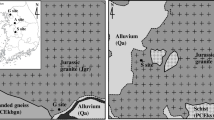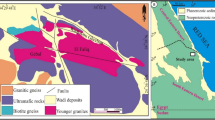Abstract
Engineering works, especially those carried out in an urban environment, generally concern shallow depths in which soil or weathered rock mass is present. The assessment of a rock mass weathering grade relies on chemical and mechanical features related to the degradation of the mechanical properties and the increase of permeability. This study aims at improving the existing knowledge on the description of rock masses’ weathering grade by indexing different weathering grade, namely, regarding mineralogical composition, fabric and microstructure, and its influence on the geomechanical parameters that the project of foundations and, in particular, the geotechnical structures demand, specifically, for the numerical modelling with view to constructive solutions. The permeability, deformability, and resistance of weathering horizons are underlined, and physical properties are to be evaluated closely related to the geological characteristics already mentioned. Given the environmental concerns to which society and the scientific community are increasingly alert, the final work will include new radiological measurements in the granite rock mass of the Porto urban area, which are added value to the geological and geomechanical knowledge of rock masses.
Access provided by Autonomous University of Puebla. Download conference paper PDF
Similar content being viewed by others
Keywords
- Granite
- Weathering profiles
- Pedological characterisation
- Geological–geotechnical characterisation
- Porto granite
1 Introduction
Weathering profiles can vary widely in the area and in-depth in the same rock mass. The spatial variability and weathering intensity depend on the rock mineralogy and texture, the discontinuities, the topography, the climate, and the groundwater conditions. The description of such profiles gave rise to proposals for the classification of weathering grade classes based on colour, friability, modifications of mineralogical composition, and microfracturing. Several authors, institutions, and technical associations proposed their weathering grade classifications. However, the ISRM classification (1978, 1981, 2007) is universally used for rock masses and considers five weathering grade (W1–W5) and one grade corresponding to residual soil (W6). A similar description is found in GSE (1995) for intact rock, which is very useful for obtaining correlations with the laboratory mechanical tests.
The influence of weathering grade on petrographic, physical, and mechanical characteristics has been studied by several authors in different lithologies (e.g., Irfan and Dearman 1978; Viana da Fonseca 1996; Arel and Tuğrul 2001). According to Letto et al. (2018), the geomechanical and mineral-petrographic properties of the rocks decrease with the weathering grade increase. Therefore, the weathering profiles' mechanical characterisation must be made for the rock masses for geotechnical purposes. Knowledge of the index properties, as listed in González de Vallejo and Ferrer (2011), which can be evaluated in laboratory tests, enables the classification of intact rocks, while field tests are usually needed for the characterisation of rock masses according to various technical criteria.
For the Portuguese granitic rock masses, widely outcropping in the country, the hypothesis arose that radon gas could be used as a plotter for geological materials’ transformation processes, both due to weathering or when subjected to stresses (Koike et al. 2015). Pereira et al. (2017) showed a possible relationship between weathering grade in granitic rocks and exhaled gas concentration.
The Granite of Porto presents weathering profiles in which the entire range of weathering grades (W1–W5) is found and a variable and erratic thickness of residual soil (W6). The main objective of this work is to present the methodologies which are used in the research being carried out, aiming to establish correlations between the geological characteristics of Granite of Porto, namely, the weathering grade, mineralogy, geochemistry, porosity, and microstructure, with the hydraulic and geomechanical properties of the rock mass, namely, the parameters of stiffness and shear strength of the granite for the various weathering grade.
The present work aims to present the methodology of the work developed in the scope of the ongoing research project. Results are not available yet and are planned to be published soon.
2 Methodology
In order to thoroughly characterise the geological–geotechnical variability of the Porto granite weathering profiles, it is fundamental that the amount of data is sufficiently broad. Furthermore, it is necessary to conduct tests that consider the mineral and chemical composition and determine the physical and mechanical properties for better characterisation. Thus, in order to carry out this study, a strategy was defined: first, the selection of sites for sampling, followed by the careful sampling and preparation of specimens; finally, the laboratory and in situ testing. For the first step, it was essential to take advantage of new excavation works in Porto city due to its extensive urban network. Moreover, the lack of outcrops available, namely, the excavation for constructing a building in the D. João I block in the city centre (Fig. 1), complemented a former sampling during the site investigation works for Metro do Porto tunnels, underground stations, and other infrastructures.
In order to minimise the samples disturbance, among the several existing sampling techniques, the block sampling method was selected, using excavation and manual moulding. This method is the most recommended for residual soils, while for un-weathered rock, the ideal sampling is obtained by drilling with continuous coring.
2.1 Pedological Characterisation and Associated Trials
The pedological characterisation is based on the FAO soil classification system—World Reference Base for Soil Resources (FAO 2015), using the internationally accepted FAO guidelines for soil description—Guidelines for Soil Description (FAO 2006)—to describe soils and their characteristics (Table 1).
2.2 Mineralogical and Geochemical Properties
For evaluating the mineralogical and textural characteristics, the petrographic analysis of thin sections, X-ray diffraction, and scanning electron microscopy are used (Table 2).
2.3 Physical Properties
The evaluation of physical properties includes water content, porosity, voids index, unit weight, and rock permeability. In addition, the size distribution and the consistency limits (Atterberg limits) are determined for the residual soils. Finally, in Table 3, the properties and respective standards, considering the need to apply the soil geotechnical classifications.
2.4 Mechanical Properties
In order to characterise the residual soil and the rock material, various mechanical properties will be determined. These tests are listed in Table 4, and the equipment used is listed.
2.5 Radiometric Methods
It is intended to use the radon accumulator method, which allows obtaining radon concentration in the samples to show the variations it presents according to the rock weathering grade. The method is based on measuring the exhalation of radon and is obtained using an Alphguard Pro2000 equipped with an ionisation chamber (University of Coimbra). Subsequently, the exhalation rate of radon is calculated.
3 Concluding Remarks
The proposed programme will contribute to the evolution of knowledge globally since, in most cases presented in the literature, the evaluation is based on a limited number of tests and samples. There is a wide variety of papers regarding laboratory tests due to the need to define the best method to reflect the variability of the geotechnical properties with the granitic rock masses' weathering grade profiles.
The methodology proposed above intends to obtain a complete characterisation to establish correlations between the rock mass's geological, hydrogeological, and geotechnical characteristics. The aim is to achieve comprehensively relevant results in granitic rock masses with varying weathering grade and in residual soils with similar properties to the materials studied in the present work.
References
Arel E, Tuğrul A (2001) Weathering and its relation to geomechanical properties of Cavusbasi granitic rocks in northwestern Turkey. Bull Eng Geol Environ 60:123–133
COBA–Consultores de Engenharia e Ambiente (2003) Carta geotécnica do Porto. 2nd edition, COBA/FCUP/CMP, Porto
FAO (2006) Guidelines for soil description. Food and agriculture organisation of the United Nations, 4 edn. Rome
FAO (2015) International soil classification system for naming soils and creating legends for soil maps–Update 2015. World reference base for soil resources. Rome, Italy
González de Vallejo LI, Ferrer M (2011) Geological engineering. CRC Press
GSE–Geological Society Engineering Group Working Party Report (1995) The description and classification of weathered rocks for engineering purposes. Quart J Eng Geol 28(3):207–242
Irfan TY, Dearman WR (1978) Engineering classification and index properties of a weathered granite. Bull Eng Geol Environ 17:79–90
ISRM—International Society for Rock Mechanics (1978) Suggested methods for the quantitative description of discontinuities in rock masses. Int J Rock Mech Min Sci Geom Abstr 15(6):319–368
ISRM—International Society for Rock Mechanics (1981) Basic geotechnical description of rock masses. Int J Rock Mech Min Sci Geom Abstr 18:85–110
ISRM–International Society for Rock Mechanics (2007) The complete ISRM suggested methods for characterisation, testing and monitoring: 1974–2006. In: Ulusay R, Hudson JA (eds) Suggested methods prepared by the commission on testing methods. ISRM, Ankar
Koike K, Yoshinaga T, Suetsugu K, Kashiwaya K, Asaue H (2015) Controls on radon emission from granite as evidenced by compression testing to failure. Geophys J Inter 203(1):428–436
Letto F, Perri F, Cella F (2018) Weathering characterisation for landslides modeling in granitoid rock masses of the Capo Vaticano promontory (Calabria, Italy). Landslides 15:43–62
Pereira A, Lamas R, Miranda DF, Neves L, Ferreira N, Costa, (2017) Estimation of the radon production rate in granite rocks and evaluation of the implications for geogenic radon potential maps: A case study in Central Portugal. J Environ Rad 166(2):270–277
Viana da Fonseca A (1996) Geomecânica dos solos residuais do granito do Porto. Critérios para o dimensionamento de fundações directas. Universidade do Porto, Porto (PhD Thesis). http://hdl.handle.net/10216/11101
Acknowledgements
RL thanks FCT-Foundation for Science and Technology for funding granted under the Ph.D. scholarship SFRH/BD/131120/2017. The authors are grateful for the support of ICT through the COMPETE 2020 project (UIDB/GEO/04683/2020) of reference POCI-01-0145-FEDER-007690. This work was financially supported by: Base Funding–114 UIDB/04708/2020 and Programmatic Funding—UIDP/04708/2020 of the CONSTRUCT—Instituto de I&D Estruturas e Construções—funded by national funds through the FCT/MCTES (PIDDAC) and by the FCT -UIDB/50019/2020- IDL project.
Author information
Authors and Affiliations
Corresponding author
Editor information
Editors and Affiliations
Rights and permissions
Copyright information
© 2023 The Author(s), under exclusive license to Springer Nature Switzerland AG
About this paper
Cite this paper
Lamas, R., Fernandes, I., Marques, J.E., da Fonseca, A.V. (2023). Methodologies for the Geological–Geotechnical Characterisation of Weathering Profiles of Granite: A Case Study. In: Chaminé, H.I., Fernandes, J.A. (eds) Advances in Geoengineering, Geotechnologies, and Geoenvironment for Earth Systems and Sustainable Georesources Management. Advances in Science, Technology & Innovation. Springer, Cham. https://doi.org/10.1007/978-3-031-25986-9_33
Download citation
DOI: https://doi.org/10.1007/978-3-031-25986-9_33
Published:
Publisher Name: Springer, Cham
Print ISBN: 978-3-031-25985-2
Online ISBN: 978-3-031-25986-9
eBook Packages: Earth and Environmental ScienceEarth and Environmental Science (R0)





